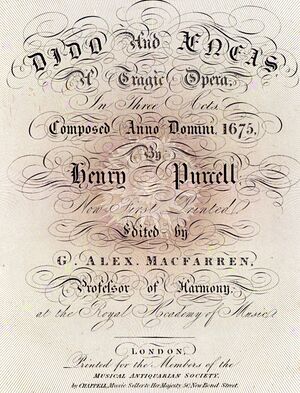Dido and Aeneas
| Dido and Aeneas | |
|---|---|
| Tragic opera by Henry Purcell | |
 Johann Heinrich Tischbein, Dido on the Pyre, 1775 | |
| Catalogue | Z. 626 |
| Libretto | Nahum Tate |
| Language | English |
| Based on | Brutus of Alba (1678) and Volume IV of the Eneida by Virgil |
| Premiere | |
| Date | Between December 1687 and summer of 1689[1] |
| Location | Mr. Josias Priest's Boarding School for Girls ( Chelsea , London ) |
Dido and Aeneas is an Opera by Henry Purcell set to words by Nahum Tate. It premiered between 1687 and 1689[1]. The claim by John Hawkins, made in The General History of the Science and Practice of Music that the opera was first performed in 1675, so Purcell would have been 19 years old at its creation[2], a claim that is quoted by G. Alexander MacFarren, professor of harmony at the Royal Academy of Music and editor of the first printed edition (c. 1841[3]), cannot be consolidated and conflicts with the Zimmermann catalogue[4]
Dido and Aeneas, after its first set of performances, was never again performed in Purcell's lifetime.[1]
Synopsis
The opera follows Dido's – the Queen of Carthage's – fate. In Purcell's and Tate's version, the call for Aeneas to abandon Dido is the work of evil witches', who hat "all in proper state".[3] At their bidding and disguised as Mercury, the messenger of the Gods, he commands Aeneas to leave Carthage – and Dido, its queen. Abandoned by her lover Aeneas, she dies; the witches triumph.[3]
Roles and premiere cast
| Role | Voice type | |
|---|---|---|
| Dido (also known as Elissa), Queen of Carthage | soprano or mezzo-soprano | |
| Belinda, Dido's sister and handmaid | light soprano | |
| Second Woman, Another Handmaiden | soprano or mezzo-soprano | |
| Aeneas, Trojan Prince | tenor or high baritone | |
| Sorceress/Sorcerer | mezzo-soprano, contralto, countertenor or bass | |
| First Witch/Enchantress | mezzo-soprano | |
| Second Witch/Enchantress | mezzo-soprano | |
| Spirit, in form of Mercury | soprano or countertenor | |
| First Sailor | tenor | |
| Chorus, SATB: all members at one point or another represent courtiers, witches, cupids, and sailors. | ||
(Table taken from English Wikipedia[1])
RSIM (Répertoire International des Sources Musicales) – OPAC
OCLC-Nummer = 2052805[5]
Manuscripts and sheet music
- Score
- Veröffentlicht:1841
- Verlag:members of the Musical Antiquarian Society
- Original aus:Bayerische Staatsbibliothek
- Dido and Aeneas. members of the Musical Antiquarian Society, at Bayerische Staatsbibliothek, originally from the University of Wisconsin - Madison. 1841.
- Sheet Music: Kalmus
- Dido and Aeneas Opera in Three Acts
- Vocal (Opera) Score with English Text
- 1961
- Boosey & Hawkes
- "Dido and Aeneas - An Opera in Three Acts". IMSLP. Retrieved October 1, 2021.
- Sheet Music: IMSLP
- "Dido and Aeneas, Z.626 (Purcell, Henry)". IMSLP. Retrieved October 1, 2021.[6]
Dido and Aeneas in Philippe Jaroussky's discography, filmography and performance history
Solo Albums/Recital albums
| Year | Title | Album |
|---|---|---|
| 2021 | "When I am laid in earth" (Dido's lament) | À sa guitare (Album) |
Concert programs
| Year | Concert Program | |
|---|---|---|
| 2021 ‐ 2022 | "When I am laid in earth" (Dido's lament) | À sa guitare (Concert program) |
| 2006 | "Stay, prince, and hear great Jove's command" | Dido and Aeneas, Théatre du Châtelet |
Complete list of musical numbers from Dido and Aeneas
This listing only contains the musical pieces performed and/or recorded by Philippe Jaroussky.
| Year published or performed | title | Album, Video or Concert Program | Year first published/performed |
|---|---|---|---|
| 2021 | "When I am laid in earth" | À sa guitare (Album) | Between December 1687 and summer of 1689[1] |
| 2021 ‐ 2022 | "When I am laid in earth" | À sa guitare (Concert program) | Between December 1687 and summer of 1689[1] |
| 2006 (performed) | "Stay, prince, and hear great Jove's command" | Dido and Aeneas, Théatre du Châtelet | Between December 1687 and summer of 1689[1] |
References
- ↑ 1.0 1.1 1.2 1.3 1.4 1.5 1.6 "Dido and Aeneas". Wikipedia. Archived from the original on October 8, 2021. Retrieved October 8, 2021.
- ↑ Hawkins, John (1776). A General History of the Science and Practice of Music. p. 499.
- ↑ 3.0 3.1 3.2 Dido and Aeneas. members of the Musical Antiquarian Society, at Bayerische Staatsbibliothek, originally from the University of Wisconsin - Madison. 1841.
- ↑ "List of compositions by Henry Purcell". Wikipedia. Archived from the original on October 1, 2021. Retrieved October 1, 2021.
- ↑ Dido and Aeneas. members of the Musical Antiquarian Society, at Bayerische Staatsbibliothek, originally from the University of Wisconsin - Madison. 1841.
- ↑ "Dido and Aeneas, Z.626 (Purcell, Henry)". IMSLP. Retrieved October 1, 2021.
